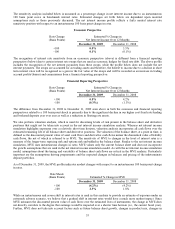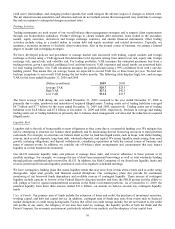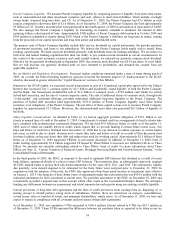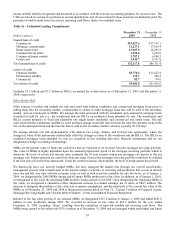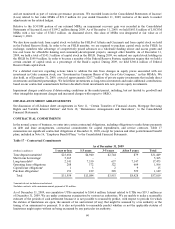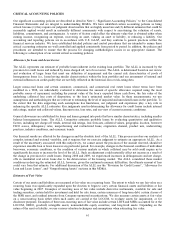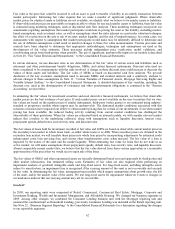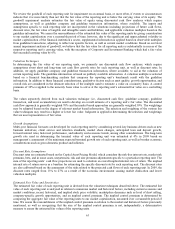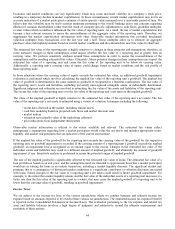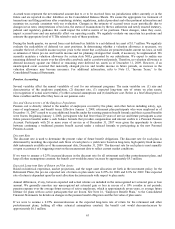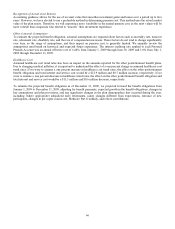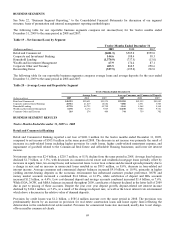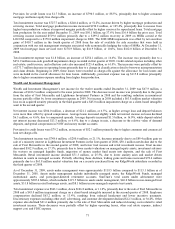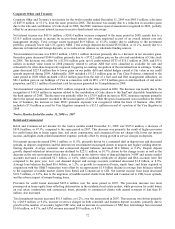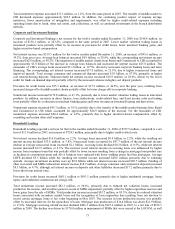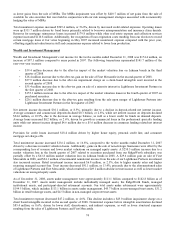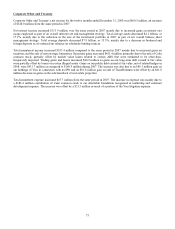SunTrust 2009 Annual Report Download - page 81
Download and view the complete annual report
Please find page 81 of the 2009 SunTrust annual report below. You can navigate through the pages in the report by either clicking on the pages listed below, or by using the keyword search tool below to find specific information within the annual report.Accrued taxes represent the net estimated amount due to or to be received from tax jurisdictions either currently or in the
future and are reported in other liabilities on the Consolidated Balance Sheets. We assess the appropriate tax treatment of
transactions and filing positions after considering statutes, regulations, judicial precedent and other pertinent information and
maintain tax accruals consistent with our evaluation. Changes in the estimate of accrued taxes occur periodically due to
changes in tax rates, interpretations of tax laws, the status of examinations by the tax authorities and newly enacted statutory,
judicial and regulatory guidance that could impact the relative merits of tax positions. These changes, when they occur,
impact accrued taxes and can materially affect our operating results. We regularly evaluate our uncertain tax positions and
estimate the appropriate level of UTBs related to each of these positions.
During the fourth quarter, we moved from a net deferred tax liability to a net deferred tax asset of $1.7 million. We regularly
evaluate the realizability of deferred tax asset positions. In determining whether a valuation allowance is necessary, we
consider the level of taxable income in prior years to the extent that carrybacks are permitted under current tax laws, as well
as estimates of future pre-tax and taxable income and tax planning strategies that would, if necessary, be implemented. We
currently maintain a valuation allowance for certain state NOLs generated by our subsidiaries. We expect to realize our
remaining deferred tax assets over the allowable carryback and/or carryforward periods. Therefore, no valuation allowance is
deemed necessary against our federal or remaining state deferred tax assets as of December 31, 2009. However, if an
unanticipated event occurred that materially changed pre-tax and taxable income in future periods, an increase in the
valuation allowance may become necessary. For additional information, refer to Note 15, “Income Taxes,” to the
Consolidated Financial Statements.
Pension Accounting
Several variables affect the annual variability of cost for our retirement programs. The main variables are: (1) size and
characteristics of the employee population, (2) discount rate, (3) expected long-term rate of return on plan assets,
(4) recognition of actual asset returns, (5) other actuarial assumptions and (6) healthcare cost. Below is a brief description of
these variables and the effect they have on our pension costs.
Size and Characteristics of the Employee Population
Pension cost is directly related to the number of employees covered by the plans, and other factors including salary, age,
years of employment, and benefit terms. Effective January 1, 2008, retirement plan participants who were employed as of
December 31, 2007 ceased to accrue additional benefits under the existing pension benefit formula and their accrued benefits
were frozen. Beginning January 1, 2008, participants who had fewer than 20 years of service and future participants accrue
future pension benefits under a cash balance formula that provides compensation and interest credits to a Personal Pension
Account. Participants with 20 or more years of service as of December 31, 2007 were given the opportunity to choose
between continuing a traditional pension benefit accrual under a reduced formula or participating in the new Personal
Pension Account.
Discount Rate
The discount rate is used to determine the present value of future benefit obligations. The discount rate for each plan is
determined by matching the expected cash flows of each plan to a yield curve based on long-term, high quality fixed income
debt instruments available as of the measurement date, December 31, 2009. The discount rate for each plan is reset annually
or upon occurrence of a triggering event on the measurement date to reflect current market conditions.
If we were to assume a 0.25% increase/decrease in the discount rate for all retirement and other postretirement plans, and
keep all other assumptions constant, the benefit cost would decrease/ increase by approximately $9.3 million.
Expected Long-term Rate of Return on Plan Assets
Based on historical experience, market projections, and the target asset allocation set forth in the investment policy for the
Retirement Plans, the pre-tax expected rate of return on plan assets was 8.25% for 2008 and 8.0% for 2009. This expected
rate of return is dependent upon the asset allocation decisions made with respect to plan assets.
Annual differences, if any, between expected and actual returns are included in the unrecognized net actuarial gain or loss
amount. We generally amortize any unrecognized net actuarial gain or loss in excess of a 10% corridor in net periodic
pension expense over the average future service of active employees, which is approximately seven years, or average future
lifetime for plans with no active participants that are frozen. See Note 16, “Employee Benefit Plans,” to the Consolidated
Financial Statements for details on changes in the pension benefit obligation and the fair value of plan assets.
If we were to assume a 0.25% increase/decrease in the expected long-term rate of return for the retirement and other
postretirement plans, holding all other actuarial assumptions constant, the benefit cost would decrease/increase by
approximately $6.1 million.
65


